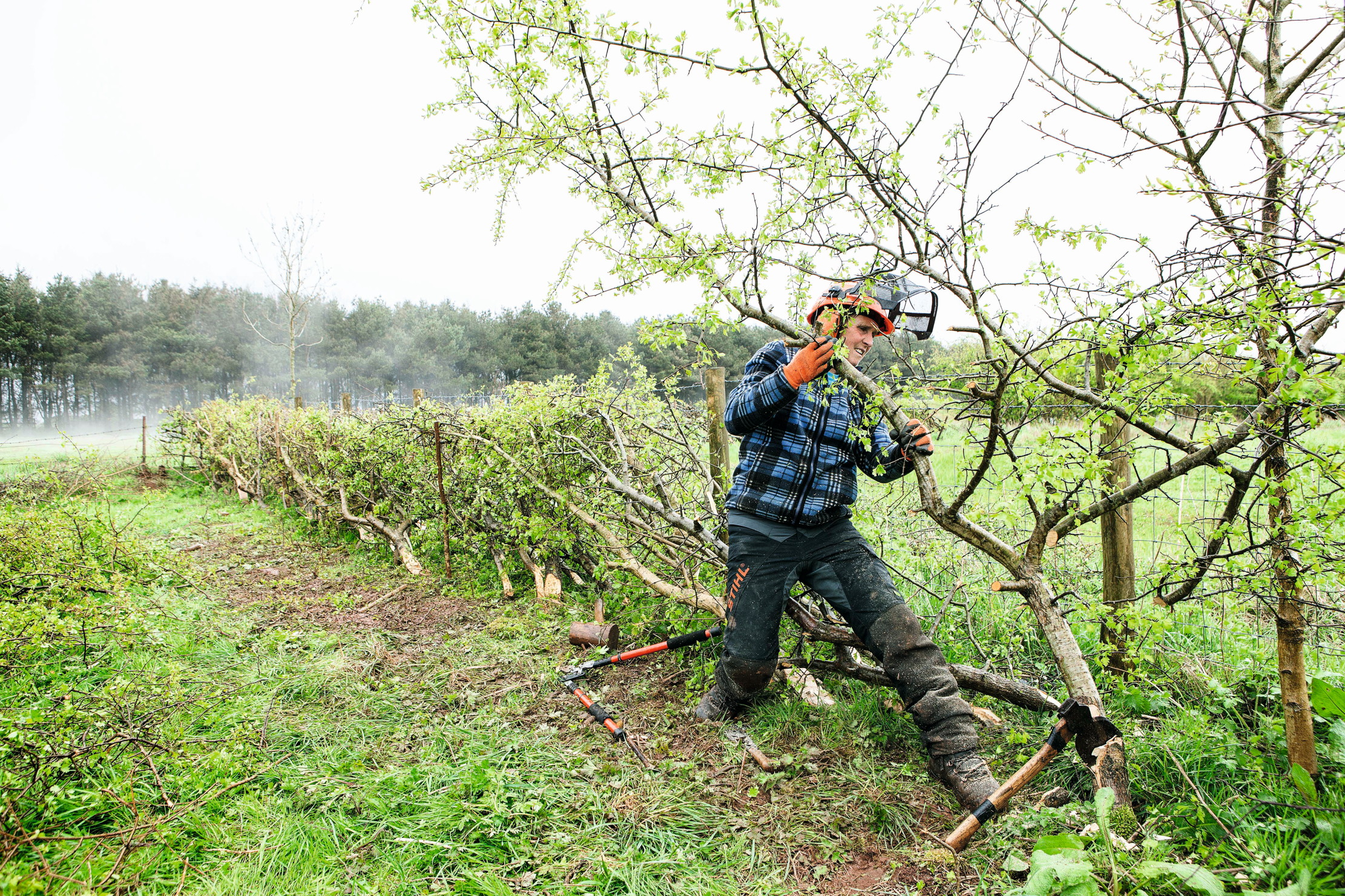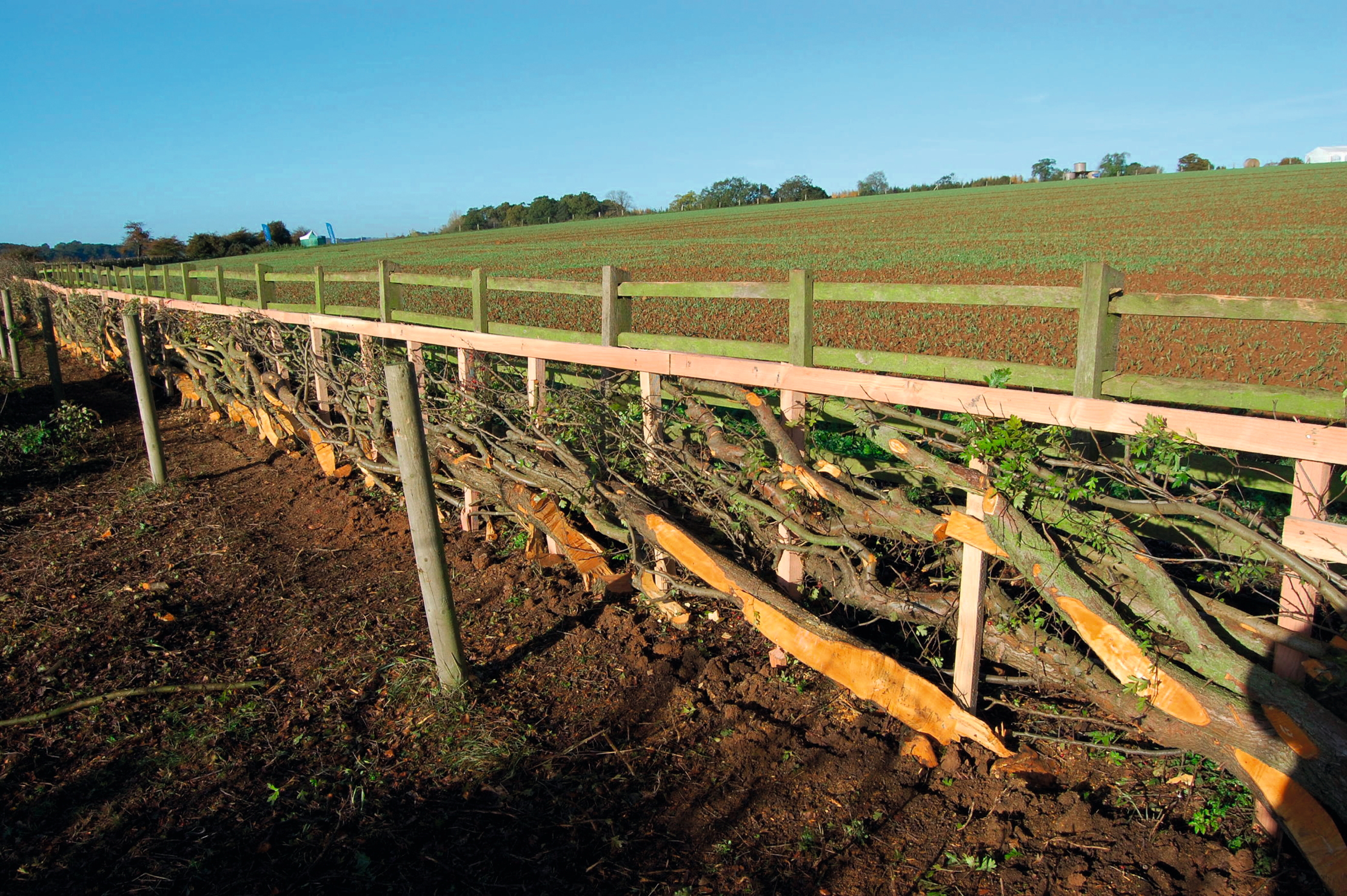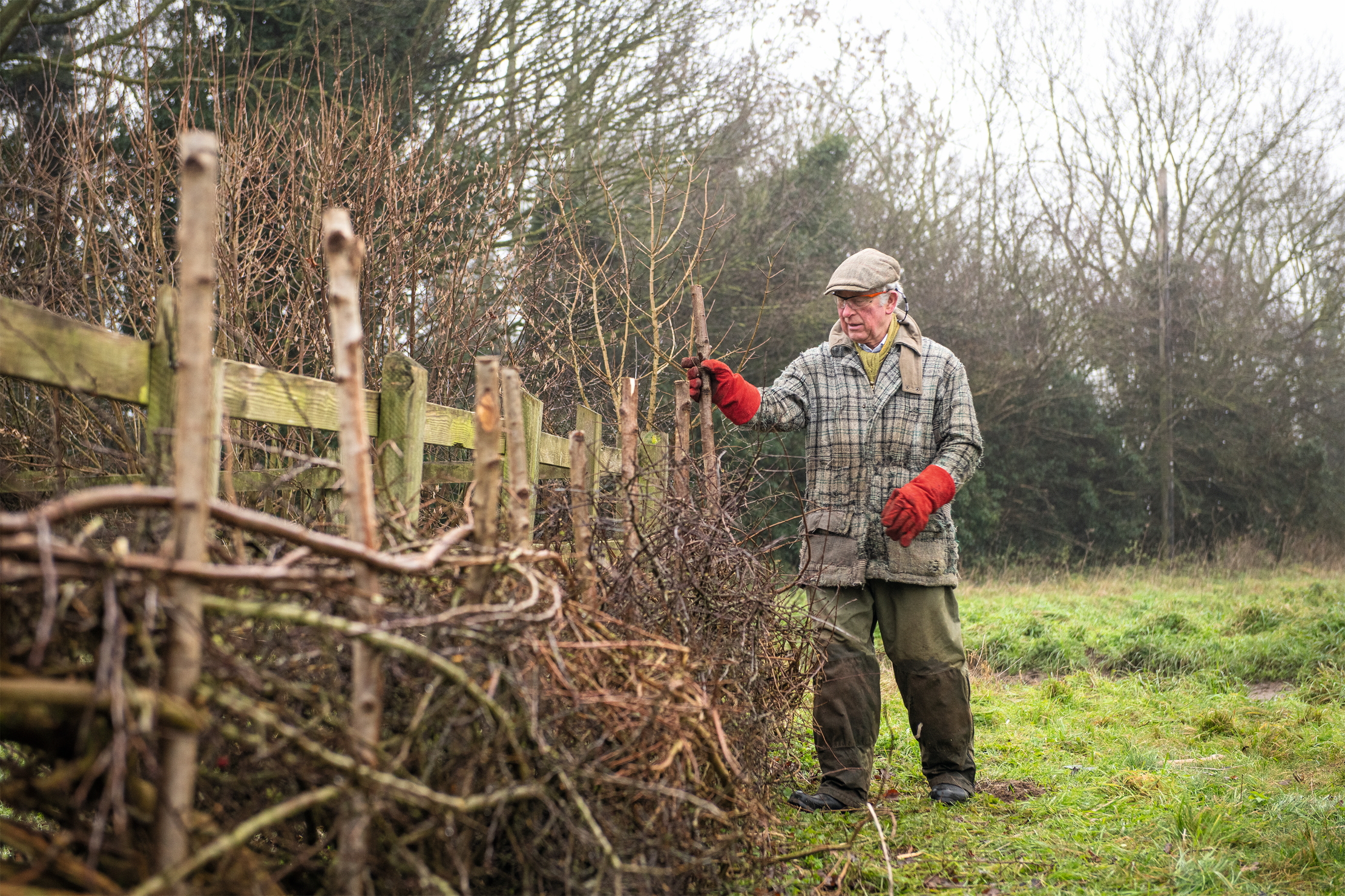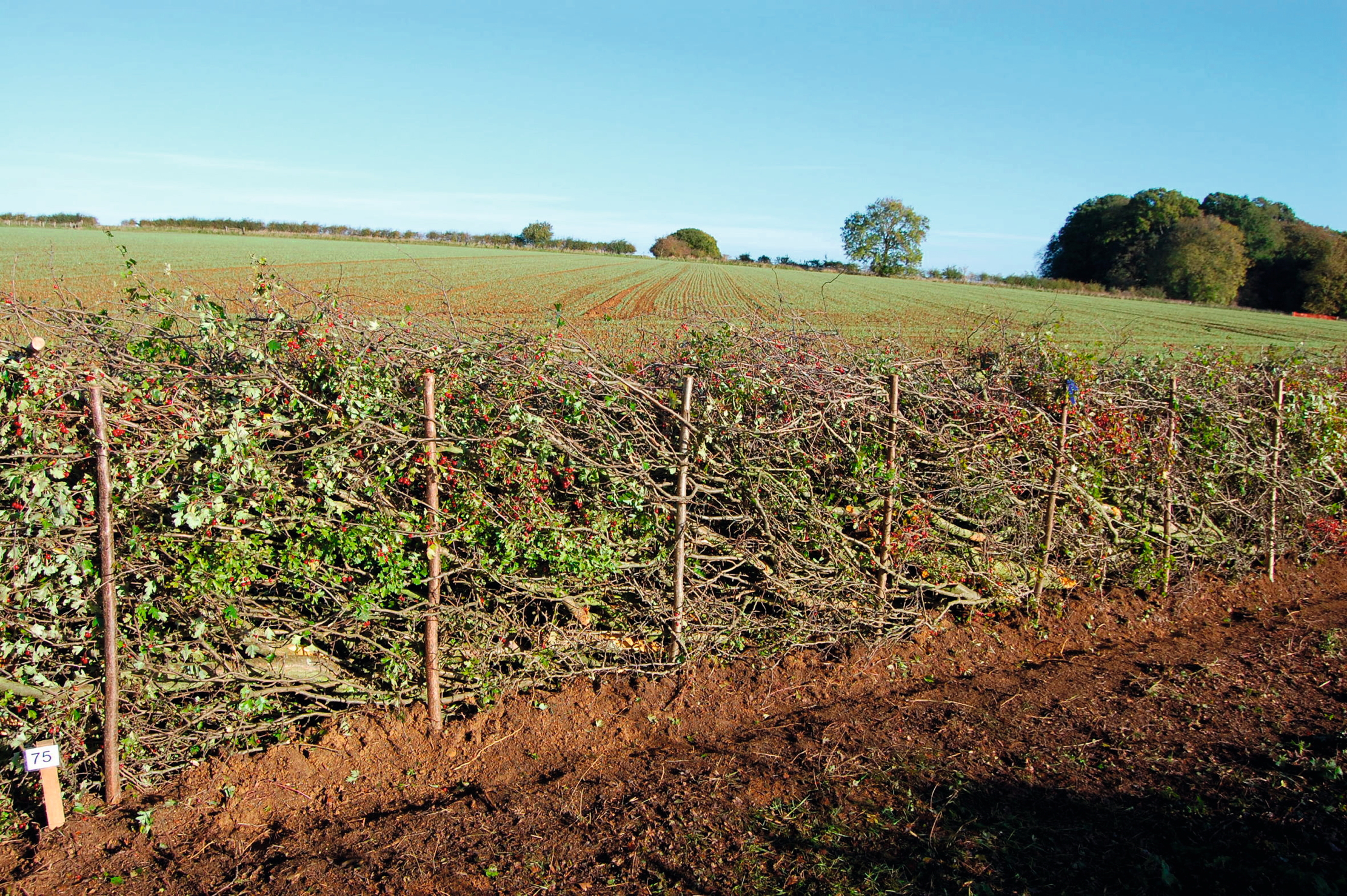Living on the hedge: The art of hedgelaying
The modern hedgelayer’s role is no longer that of a fencer, but instead a practical conservationist creating vibrant, thorny arteries of hedgerow habitat, says Richard Negus.


It is impossible to say precisely when the first hedge in Britain was laid, yet it is beyond doubt that our hedgerows are the oldest in Europe. This truth came to light in the early 1980s, when archaeologist Francis Pryor and a team from Cambridge unearthed the traces of a hedged-in sheep fold and livestock market in the stark peatlands of Flag Fen near Peterborough, Cambridgeshire. A nondescript piece of blackened hedgerow brash was exposed, visibly clean cut and angled, indicative of trimming with, one supposes, a billhook.
When radiocarbon-dated, this barb helped to prove that some 4,500 years ago, people here were already well established in agricultural practices familiar to us today — mixed farming, draining land and managing hedgerows. It stands to reason, then, that if the hedge was integral to this proto-agricultural Bronze Age landscape, then so too were hedgelayers.
This belief in my trade’s antiquity is no display of hubris, more old-fashioned common sense. The hedge is and always will be a manmade construct, each one planted by human hand to fulfil practical agricultural roles. Then as now, if a hedge is to remain as a hedge, rather than morphing into a linear wood or rambling scrub block, it requires the intervention of man.
Our national hedgerow network is eclectic, reflecting the remarkably localised differences in soil, climate and terrain that determine agricultural land use. The regional styles of hedgelaying, regarded as near art forms by some, only emerged as a result of these sectarian deviations of the land. Before exploring these variations, it is important to first understand what is meant by hedgelaying.

Hedgelaying involves making a partial downwards angled cut through the basal stem of a hedgerow shrub. The layers of bark, cambium and inner sapwood remain connected to the root stock via the thin tongue left after the clean slash has been made with billhook, axe or chainsaw. The tongue allows the stem, now known as a pleacher, to be bent over at an angle, usually between 30–45 degrees; the heel that remains behind the tongue is cut cleanly off. The thin yet pliable tongue is all that is needed to supply sap, water and nutrients to the laid pleacher. Sap runs uphill, therefore downward-facing shoots and branches are removed, as well as any dead wood, invasive bramble, briony and clematis or stems that are surplus to requirement. Further nicks and cuts are made along the length of every pleacher, ‘building’ the hedge so that each lays neatly one a-top the next.
The process is repeated along the entire hedge length. In many cases, the laid pleachers are retained by stakes of hazel, sweet-chestnut or sycamore driven into the ground. Frequently, the stakes are bound with longer whippy lengths of hazel or willow, increasing the rigidity of the whole. When the laid hedge grows back in the spring, the cleancut heels coppice, producing vertical shoots; buds along the laid pleachers erupt, filling in gaps. Like an armoured fighting vehicle’s Chobham armour, this lattice of shoots grows in a semi-ordered jumble, creating a bottom-to-top thick barrier of thorn.
The obvious question to ask, when barbed wire or electric fencing can provide economical and less labour-intensive stock fencing, is why even bother to lay hedges today? Equally, is there any need to stock-proof land? After all, vast swathes of East Anglia, for example, are dedicated to arable and vegetable production.
Exquisite houses, the beauty of Nature, and how to get the most from your life, straight to your inbox.

The answer is straightforward. Archaic as they are, hedges continue to hold numerous agricultural roles. A hedgerow — even one back-fenced by wire — provides year-round shelter from the elements for livestock. In arable rotations, the hedge is a wind break and acts as a filter, preventing soil, chemicals or fertilisers from leaching into water courses. Many of the reasons our Bronze Age forebears first planted, then managed hedgerows, therefore, still hold true today. Yet the modern hedge has a role that agrarians of former times would have thought largely inconsequential.
For farmland wildlife, the British hedgerow today is a life saver. Much is made of the hedgerows deemed lost since the end of the Second World War. This simplistic sound-bite ignores the truth that hedgerows have always been a fluctuating feature, reflecting agricultural booms and busts and the shifting patterns of farming fashion and consumer need.
What is true, however, is that post-war decline of hedgerows, when combined with intensive, chemically aided food production, has had a disastrous effect on Nature. Managing our existing hedgerows better — rather than simply planting new ones — guarantees food, shelter and nesting sources for a litany of bird, mammal, invertebrate and reptile species. When partnered with uncultivated field margins, these manmade, linear combinations of hedgerow and grassland re-create the truly lost habitats of rural England — scrublands and meadows.

The thoroughly modern hedgelayer’s role is no longer that of a fencer, repairing gaps and preventing livestock from straying. Instead, we are practical conservationists, creating hedgerow habitats and thickening the base, density being the most important factor in wildlife-friendly hedgerows, whereas height and width are largely irrelevant. Whether rejuvenating older hedgerows or improving younger lines, hedgelaying morphs gappy, sparse and straggly lengths into vibrant, thorny arteries that connect habitats together, providing safe corridors along which wildlife can dwell and travel, protected from predators and the elements.
My business partner and I lay some 13,000ft of East Anglian hedgerows each season. On farm drives and in prominent positions, we adopt the Midland style, but for 80% of our farmland hedges we lay in a ‘conservation style’, shunning pre-cut stakes and instead pollarding stems roughly 3ft apart and cut at 3½ft tall. We weave our laid pleachers into these living stakes and rarely bind the top.
Our lack of adherence to tradition does raise the eyebrows of some purists, yet it is a style designed for our local terroir and developed through experience and pragmatism. We briefly believed this East Anglian style, as we call it, to be unique and worthy of note. This vision was recently dashed when a beef farming correspondent from south-west Wales contacted me after seeing an example of our work on Twitter (now X). ‘I am delighted you are using the Carmarthenshire style,’ he wrote. Which goes to show, with a heritage as old as ours, that in hedgelaying there is nothing new under the sun.
Richard Negus is a hedgelayer, journalist and author. He lives in Suffolk. His book 'Words From the Hedge: A Hedgelayer’s View of the English Countryside' will be published by Unbound in May 2025

There's dinosaurs in them thar hills: How Britain discovered the Megalosaurus
There's not much to say about the Oxfordshire village of Stonesfield, apart from the fact that it was once 'covered
Country Life is unlike any other magazine: the only glossy weekly on the newsstand and the only magazine that has been guest-edited by His Majesty The King not once, but twice. It is a celebration of modern rural life and all its diverse joys and pleasures — that was first published in Queen Victoria's Diamond Jubilee year. Our eclectic mixture of witty and informative content — from the most up-to-date property news and commentary and a coveted glimpse inside some of the UK's best houses and gardens, to gardening, the arts and interior design, written by experts in their field — still cannot be found in print or online, anywhere else.
